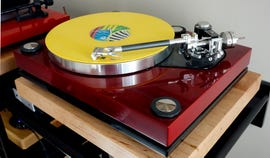While subwoofers are all but required for home theater, the role subs play in music systems is almost as crucial. So even if you have a pair of bookshelf or tower speakers with 5-inch or smaller woofers and are perfectly satisfied with the bass, you literally don’t know what you’re missing. Adding a sub to larger speakers also makes sense — in fact, all but the most humongous speakers benefit from adding a sub.
Here’s the best part: Adding a sub isn’t just about more bass. With a great sub the system’s dynamics rock harder, and soundstage depth and spaciousness improve. A well-matched sub will dramatically enhance the overall sound of your system, and adding the right sub will make a bigger difference than upgrading electronics.

Steve Guttenberg/CNET
That was certainly the case with enthusiast Jeff K.’s hi-fi, which sports a pair of Zu Audio Soul Supreme towers, which have 10-inch (254mm) woofers. After consulting with the folks at Zu Audio he took the plunge and bought their Undertone Mk. II subwoofer.
I’ve heard Jeff’s system before so I was eager to hear how the sub changed the sound. Subs are at their best when they’re not calling attention to themselves. That is, you shouldn’t be aware of any bass coming from the subwoofer, all of the bass should seem to come from the speakers. Ah, but when you turn off the sub you’ll be amazed by what the sub was contributing, even with recordings that didn’t have a lot of bass!
In Jeff’s room the Undertone Mk. II provided a much deeper foundation for the music. There was a newfound solidity to the sound that the Soul Supremes on their own couldn’t match. Jeff thinks the sub made a huge improvement to the overall sound of his system, and not just the bass. The music’s energy and dynamics kicked harder, turning off the sub and returning to just the Supremes was a letdown.
Jeff spent hours turning me onto new music — he has 2,500 LPs, a few hundred singles and 2,000 CDs. I’d never heard of Jackie Mittoo, but his organ-fueled instrumentals fully exercised the system. Then we went deep into a few Treasure Isle (a Jamaican record label) collections, and the bass textures and rhythms were fantastic. The Undertone MK. II’s contributions were hard to miss, so when we turned the sub off the Soul Supremes sounded smaller and less energetic. When I asked Jeff if he could go back and run the system sans sub he said no way. After all, the bass is part of the music, and now he’s hearing and feeling it.


Steve Guttenberg/CNET
The Undertone Mk. II measures 25 by 15 by 15 inches (635 by 38 by 38cm), it weighs 68 pounds (31kg), and is offered in a range of finishes. This sub can be used with other brands of speakers, as long as they produce bass down to 60 or 70Hz; the Undertone Mk. II won’t mate well with really small monitor or satellite speakers. It’s a sealed box (non-ported) design, with a 12-inch (305mm) Eminence LAB 12 paper cone driver. Connectivity runs to speaker- and line-level inputs, and a LFE input. The internal amp is rated at 400 watts. You can definitely add this sub to any stereo system, even ones that don’t have dedicated subwoofer output jacks.
The Undertone Mk. II runs $2,000 in the US (around £1,300 or AU$2,700 converted) — not steep by high-end standards, but that’s still a lot of money. If that’s out of range I can’t say enough nice things about the more affordable JL Audio E-Sub e110 sub, and Hsu Research’s even more affordable subs are awfully good.
Zu sells direct with an unusually long 60 day, no-risk return policy in the US, and through its distributors in the UK and Australia.




